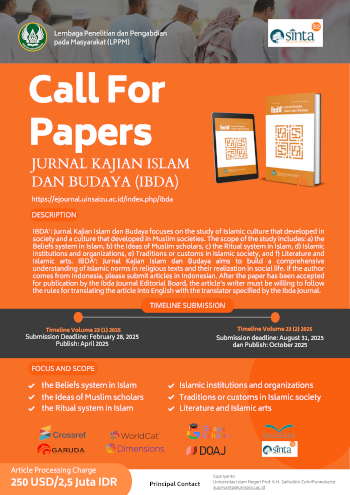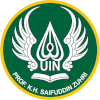Religious culture reflection of young Muslims community
DOI:
https://doi.org/10.24090/ibda.v21i1.7877Keywords:
life, religious culture, young Muslims, ACM communityAbstract
The identity formation of young Muslims is a complex issue influenced by various factors such as transition, culture, religion, and external factors like parents and environment. Despite facing challenges, young Muslims have the power to adapt, select, and appropriate their cultural identity in the contemporary Islamic era. This study aims to describe the reflection of religious life through three dimensions: belief, worship, and social society. The young Muslim ACM (Ayo Cinta Masjid) community has various social activities and strong religious culture. Through these practices, the ACM community strives to build and apply the practice of religiosity as a fancy religious life identity while maintaining the basic values and Islamic principles. The construction of ACM community religiosity identity begins with various religious activities such as congregational prayers, great recitation (tablīgh akbar), ACM riders subuhan, sharing time weekends, ACM volunteers, prepekan, and other activities. In the worship dimension, the religiosity of the ACM community can be identified from the intensity and the practice of worship in daily life through various religious activities. Meanwhile, in the social dimension, the religiosity of the ACM community is reflected in social life by carrying out positive and constructive activities for others based on religious awareness.Downloads
References
Ahimsa-Putra, H. S. (2012). Fenomenologi agama: Pendekatan fenomenologi untuk memahami agama. Walisongo: Jurnal Penelitian Sosial Keagamaan, 20(2), 271–304. https://doi.org/10.21580/ws.20.2.200
Arief, Y., & Utomo, W. P. (2015). Orde media: Kajian televisi dan media di Indonesia pasca Orde Baru. Insist Press.
Creswell, J. W. (1998). Qualitative inquiry and research design: Choosing among five traditions. Sage Publication.
Daradjat, Z. (2005). Ilmu jiwa agama. Bulan Bintang.
Erikson, E. H. (1968). Identity, Youth, and Crisis. W.W. Norton and Company.
Faisal, I. (1997). Paradigma kebudayaan Islam: Studi kritis dan refleksi historis. Titian Ilahi Press.
Geertz, C. (1992). Kebudayaan dan agama (F. B. Hardiman (Trans.)). Kanisius.
Guntoro, G. (2020). Transformasi budaya terhadap perubahan sosial di era globalisasi. Jurnal Asketik Agama Dan Perubahan Sosial, 4(1), 22–33. https://doi.org/10.30762/asketik.v4i1.1004
Hasan, N. (Ed.). (2020). Islam Indonesia 2020. UII Pres.
Ishomuddin, I. (2002). Pengantar sosiologi agama. Ghalia Indonesia.
Kailani, N. (2019). Preachers-cum-trainers: The promoters of market Islam in Urban Indonesia. In N. Saat (Ed.), Islam in Southeast Asia: Negotiating modernity. Cambridge University Press.
Kamad, D. (2002). Sosiologi agama. Remaja Rosdakarya.
Koentjaraningkat. (1992). Pokok-pokok antropologi sosial. Dian Rakyat.
Mubarok, A. (2008). Konfigurasi dan transformasi kehidupan beragama generasi muda pedesaan: Studi kasus generasi muda Desa Pakiskembar Kecamatan Pakis Kabupaten Malang Jawa Timur. Analisa, 15(2), 123–144. https://doi.org/10.18784/analisa.v15i02.337
Naafs, S. (2018). Youth aspirations and employment in provincial Indonesia: A view from the lower middle classes. Children’s Geographies, 16(1), 53–65. https://doi.org/10.1080/14733285.2017.1350634
Naafs, S., & White, B. (2012). Intermediate Generations: Reflections on Indonesian Youth Studies. The Asia Pacific Journal of Anthropology, 13(1), 3–20. https://doi.org/10.1080/14442213.2012.645796
Naim, A. A. A. (2000). Human rights and Islamic identity in France and Uzbekistan: Mediation of the local and global. Human Rights Quarterly, 22(4), 906–941. https://doi.org/10.1353/hrq.2000.0046
Nilan, P., & Mansfield, M. (2013). Youth culture and Islam in Indonesia. Wacana: Journal of the Humanities of Indonesia, 15(1), 1–18. https://doi.org/10.17510/wjhi.v15i1.102
Nilan, P., Parker, L., Bennett, L., & Robinson, K. (2011). Indonesian youth looking towards the future. Journal of Youth Studies, 14(6), 709–728. https://doi.org/10.1080/13676261.2011.580523
Noble, S. U. (2018). Algorithms of Oppression, How Search Engine Reinforce Racism. The New York University Press.
Pals, D. L. (2006). Eight theories of religion. Oxford University Press.
Ritzer, G. (2007). Sosiologi Ilmu Pengetahuan Berparadigma Ganda (Alimandan (Trans.)). RajaGrafindo Persada.
Robinson, K. (Ed.). (2016). Youth identities and social transformations in modern Indonesia. Brill.
Saluz, C. N. (2007). Islamic pop culture in Indonesia is an anthropological field study on veiling practices among Gadjah Mada University of Yogyakarta students (Issue 41). Institut für Sozialanthropologie.
Sarwono, S. (2013). Anak Jakarta a sketch of Indonesian youth identity. Wacana: Journal of the Humanities of Indonesia, 15(1), 41–65. https://doi.org/10.17510/wjhi.v15i1.104
Sharif, M. M. (1996). A History of Muslim Philosophy. Otto Harrassowitz.
Sunesti, Y., Hasan, N., & Azca, M. N. (2018). Young Salafi-niqabi and hijrah: Agency and identity negotiation. Indonesian Journal of Islam and Muslim Societies, 8(2), 173–198. https://doi.org/10.18326/ijims.v8i2.173-198
Wach, J. (1963). Sosiologi of relegion. The University of Chicago Press.
Downloads
Published
How to Cite
Issue
Section
License
Copyright (c) 2023 Guntoro, Noorhaidi Hasan

This work is licensed under a Creative Commons Attribution-ShareAlike 4.0 International License.
Authors who publish with this journal agree to the following terms:
- Authors retain copyright and grant the journal right of first publication with the work simultaneously licensed under a Creative Commons Attribution-ShareAlike License a that allows others to share the work with an acknowledgement of the work's authorship and initial publication in this journal.
- Authors are able to enter into separate, additional contractual arrangements for the non-exclusive distribution of the journal's published version of the work (e.g., post it to an institutional repository or publish it in a book), with an acknowledgment of its initial publication in this journal.
- Authors are permitted and encouraged to post their work online (e.g., in institutional repositories or on their website) before and during the submission process, as it can lead to productive exchanges, as well as earlier and greater citation of published work (See The Effect of Open Access).
















